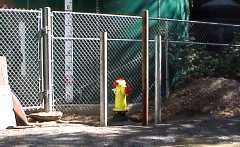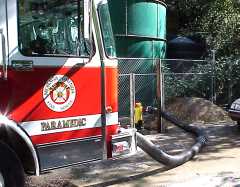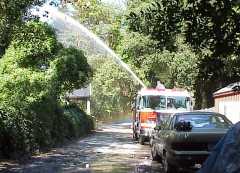© 2001 Capt. Willis Lamm, Water Supply Officer, Moraga-Orinda (CA) Fire District |
The following procedures are examples of low water pressure evolutions based on the procedures of the Moraga-Orinda Fire District, presented for illustrative purposes.This hydrant is connected to the Canyon School water tank via a dedicated 6" line. Since the hydrant is at the same level as the tank, it has an average static pressure of only 7 psi with an available flow at normal head pressure of about 315 GPM. However by using hard suction, flows of about 850 GPM can be obtained. Typically about 20,000 gallons of water are available from the tank. |
Hydrant outside the fence,
|
| GETTING EFFECTIVE WATER SUPPLY |
A logical operational sequence to provide water supply and still maintain
roadway access along Northern Railway is as follows:
|
|
The roadway is narrow so tight, parallel parking is important. An appropriate sequence of actions is:
|
Hard suction layout
|
Return to Drafting from Low Pressure Hydrants Index
Return to Water Supply Index
Back to Information Section
|
Unless otherwise noted, all contents of these WWW pages © 1996-2002, FireHydrant.org |


